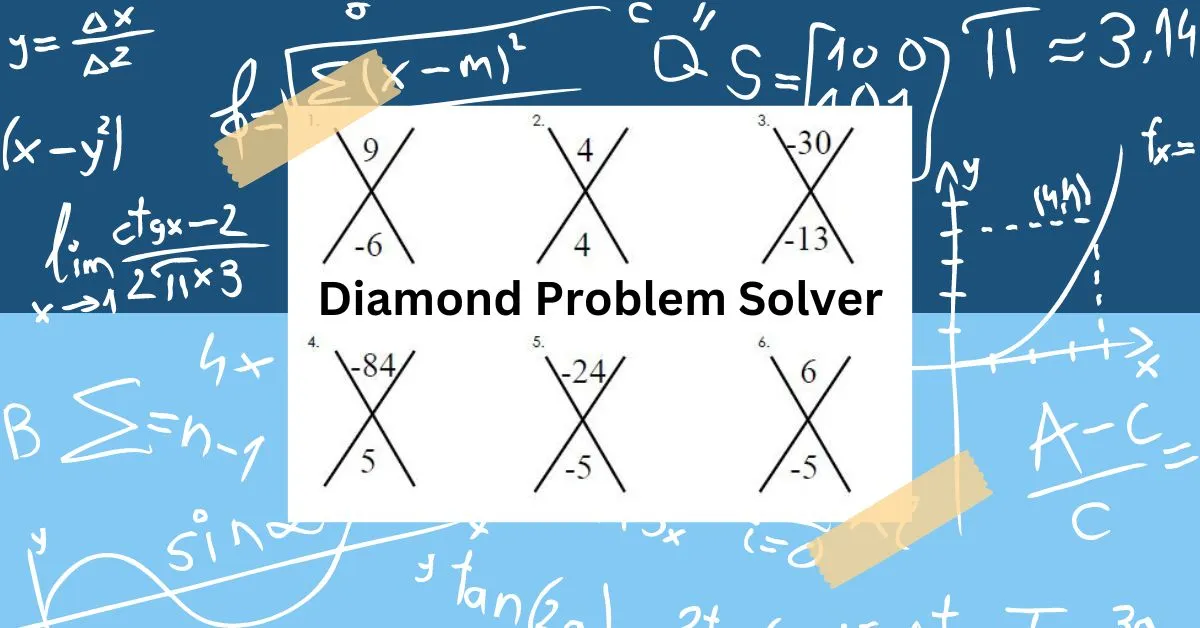Diamond Problem Solver: Your Ultimate Guide to Mastering Diamond Math
Do you ever feel puzzled by those tricky diamond math problems? You’re not alone! But don’t worry, we’ve got just the thing to help you out. Our guide is packed with easy-to-understand tips and tricks to crack those diamond puzzles wide open. Plus, we’ll introduce you to our handy diamond problem solver that’ll make math a breeze!
Ever wondered what diamond problems are all about? They’re basically math puzzles shaped like diamonds with numbers inside. Our guide breaks down these puzzles into simple steps, so you’ll know exactly what to do. And with our solver, you can say goodbye to math confusion – just plug in the numbers, and voila! The answers are right there.
So, are you ready to conquer those diamond problems once and for all? Let’s dive in and unravel the mystery together. Scroll down to get started – your math victory awaits!
Understanding Diamond Problems
What are Diamond Problems?
Diamond Problems solver, also known as a diamond problem Calculator. A diamond problem, in the realm of mathematics, is not about sparkling gemstones or luxurious diamond rings but rather a type of mathematical exercise presented in a diamond shape. Though we can teach you how to Calculate Diamond Weight. This shape resembles a rhombus, with four sections forming a cross. In a diamond problem, you encounter four fields where numbers are filled in, each related by a mathematical operation. The left and right sides of the diamond contain two numbers, often referred to as factors. The top section displays their product, while the bottom section shows their sum.
The objective of solving a diamond problem is to find the missing numbers when you only know two out of the four. This task requires you to discern the relationship between the given numbers and apply mathematical principles to deduce the unknown values. There are three primary types of diamond problems, each presenting its own set of challenges. These include scenarios where you’re given two factors, one factor along with either the product or sum, or the product and sum without knowing the numbers themselves. A diamond problem calculator is a handy tool that can assist in solving these mathematical puzzles efficiently.
Types of Diamond Problems
Diamond problems come in various types, each presenting its own set of challenges and requiring distinct problem-solving approaches.
Case 1: Given Two Factors
The first case, involves being given two factors and tasked with finding their sum and product. This type is often considered the beginner’s level, serving as an introduction to the concept of diamond math. In this scenario, users are provided with a relatively straightforward task of identifying the relationships between the given numbers and determining their combined and multiplied values within the diamond grid.
Case 2: Given One Factor, and the Product or Sum
Moving on to Case 2, individuals are presented with one known factor alongside either the product or sum of the numbers. This type of diamond problem demands a bit more critical thinking and problem-solving skills compared to Case 1. Users must decipher the missing information by strategically manipulating the provided numbers and applying mathematical operations to uncover the complete solution. While slightly more challenging, Case 2 serves as an excellent opportunity for learners to enhance their analytical abilities and deepen their understanding of diamond math principles.
Case 3: Given Product and Sum, While Searching for Factors
Lastly, Case 3 represents the advanced level of diamond problems, where users are given the product and sum of the numbers but not the numbers themselves. This type of problem requires users to engage in a more complex and intricate puzzle-solving process, akin to piecing together a jigsaw puzzle without knowing the image beforehand. Users must carefully analyze the relationship between the product, sum, and potential factors to deduce the missing numbers accurately. Despite its heightened difficulty level, Case 3 offers a rewarding challenge for those seeking to refine their problem-solving skills and delve deeper into the intricacies of diamond math.
How to Use a Diamond Problem Calculator
Using the Diamond Problem calculator is a simple and efficient process. To begin, users input the known numbers into the corresponding fields of the calculator. For instance, if given two factors, users enter these factors into the appropriate sections of the calculator. Once the numbers are entered, users click the “Solve” button to prompt the calculator to compute the missing numbers.
For example, suppose a user is presented with the problem where the left and right factors are 6 and 9, respectively. After inputting these numbers into the calculator, the user clicks “Solve.” The calculator then reveals that the top number is 54 and the bottom number is 15, completing the diamond grid. Users can then verify these results and proceed with confidence.
Additionally, the calculator accommodates more complex scenarios where users are given one factor along with either the product or sum. In such cases, users follow similar steps by inputting the provided information and clicking “Solve” to obtain the missing numbers. This user-friendly approach makes the Diamond Problem calculator a valuable tool for navigating through various mathematical challenges with ease and precision.
How to Solve Diamond Problems
Let’s delve into the nitty-gritty of solving diamond problems. Whether you’re a math whiz or someone who breaks into a sweat at the sight of equations, we’ve got you covered.
Step-by-Step Guide:
- Start with the Basics: Begin by thoroughly understanding the information given in the problem. Identify the type of diamond problem you’re dealing with, whether it involves two factors, one factor and the product or sum, or just the product and sum.
- Apply the Relevant Case: Depending on the type of diamond problem identified, apply the corresponding solving method. For instance, if you’re given two factors, use the method appropriate for that scenario. If you have one factor and the product or sum, adjust your approach accordingly.
- Break it Down: Don’t feel overwhelmed if the problem seems complex. Break it down into smaller, more manageable steps. Tackle each part methodically, focusing on one aspect at a time to avoid confusion.
- Double-Check Your Answers: Math demands precision, so it’s crucial to double-check your calculations to ensure accuracy. Review your work carefully to catch any errors or miscalculations before proceeding.
- Practice, Practice, Practice: Like any skill, mastering diamond problems requires practice. Dedicate time to solving various types of diamond problems regularly. The more you practice, the more familiar you’ll become with different problem-solving techniques, increasing your confidence and proficiency over time.
Benefits of Using a Diamond Problems Solver
- Simplifying Complex Equations: Diamond problems serve as a bridge to understanding more complex mathematical concepts. By using a solver, users can simplify intricate equations and gain a clearer understanding of underlying mathematical principles.
- Enhancing Learning Experience: A Diamond Problems Solver isn’t just a tool; it’s a companion in the mathematical journey. It provides instant solutions, allowing users to focus on understanding concepts rather than getting bogged down by calculations.
- Improving Problem-Solving Skills: By utilizing a Diamond Problem Calculator, users can refine their problem-solving skills. The solver encourages critical thinking and analytical reasoning, helping users tackle a variety of mathematical challenges with confidence.
- Increasing Efficiency: Solving diamond problems manually can be time-consuming and prone to errors. With a solver, users can swiftly obtain accurate solutions, saving time and minimizing the risk of mistakes.
- Encouraging Exploration: A Diamond Problem Calculator encourages users to explore different problem-solving techniques and strategies. It fosters curiosity and a deeper engagement with mathematics, leading to a more enriching learning experience.
Diamond Problem Calculator Helpful for Students and Teachers
The Diamond Problem Calculator is undeniably beneficial for both students and teachers in the realm of mathematics education.
For Students:
Particularly those grappling with the intricacies of diamond problems, this tool serves as a reliable guide and learning companion. By providing instant solutions to complex mathematical puzzles, the calculator empowers students to verify their answers efficiently. This instant feedback not only helps students gauge their understanding but also fosters a sense of confidence in their problem-solving abilities. Moreover, the calculator encourages active engagement with mathematical concepts, as students can explore various problem-solving techniques and refine their skills through practice.
For Teachers:
Similarly, for teachers, the Diamond Problem Calculator offers a versatile instructional tool to enhance the teaching and learning experience in the classroom. Educators can utilize the calculator to demonstrate problem-solving strategies and elucidate mathematical concepts with concrete examples. By incorporating the calculator into lesson plans and activities, teachers can facilitate meaningful discussions and foster a deeper understanding of mathematical principles among students. Furthermore, the accessibility of the calculator enables teachers to differentiate instruction and provide personalized support to students at varying levels of proficiency. Whether used for whole-class instruction, small-group work, or independent practice, the Diamond Problem Calculator empowers teachers to create dynamic and engaging learning environments that promote mathematical literacy and critical thinking skills.
Conclusion
In conclusion, mastering diamond math doesn’t have to be a daunting task. With the right tools and knowledge at your fingertips, you can tackle any diamond problem with confidence. From understanding the basics to applying advanced solving techniques, our comprehensive guide has equipped you with everything you need to succeed. And with the assistance of our intuitive diamond problems solver, navigating through mathematical challenges has never been easier.
So, the next time you encounter a diamond problem, remember that you’re well-equipped to handle it. Approach each puzzle with curiosity and determination, knowing that you have the skills and resources to find the solution. With practice and perseverance, you’ll become a diamond math expert in no time. Keep exploring, keep learning, and most importantly, keep shining bright in the world of mathematics!
FAQs:
What are the benefits of using a diamond problem calculator?
A diamond problem calculator simplifies complex equations, enhances the learning experience, improves problem-solving skills, increases efficiency, and encourages exploration of different problem-solving techniques.
How do I know which case of diamond problem I’m dealing with?
Identify the information given in the problem, such as two factors, one factor and the product or sum, or just the product and sum, to determine the relevant case.
Can a diamond problem calculator handle all types of diamond problems?
Yes, a diamond problem calculator is designed to assist with all types of diamond problems, from simple cases with two factors to more complex scenarios involving products and sums.
Is practice necessary to master diamond problems?
Yes, like any skill, mastering diamond problems requires practice. Regular practice helps improve problem-solving abilities and builds confidence in tackling different types of problems.
How can I use a diamond problem calculator effectively?
Simply input the known numbers into the solver and click “solve” to obtain the missing numbers. Review the results carefully to ensure accuracy and understanding of the problem.







